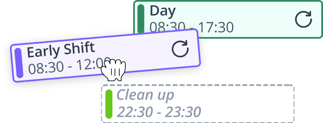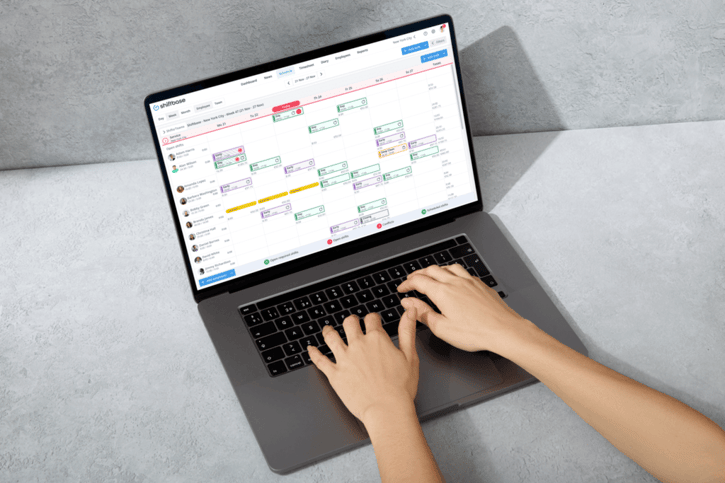In this guide, we’ll walk you through the different types of work schedules, how to choose the right one, and what to watch out for as an employer.
What is a work schedule?
A work schedule simply tells you who works, when, and for how long. It’s the plan that maps out employee shifts across days, weeks, or months—helping you keep operations smooth and people in the right place at the right time.
But it’s not just about avoiding chaos.
A well-structured schedule also helps:
- Control labour costs
- Improve team productivity
- Reduce burnout and absenteeism
- Stay compliant with labour laws (hello, Working Time Regulations!)
Whether you’re running a retail store or managing a hybrid team in an office, choosing the right schedule makes a world of difference.
Work schedule types
Work schedules aren’t one-size-fits-all. Let’s walk through the most common ones so you can spot what works best for your team.
Fixed schedule
This is your classic 9-to-5 setup. Employees work the same hours on the same days every week. It's predictable and structured.
👉 Example: Sarah works from 8:30am to 4:30pm, Monday to Friday, every week.
✅ Why it works:
- Easy to manage
- Great for routine tasks and office-based roles
- Employees know exactly what to expect
❌ Downsides:
- Doesn’t offer flexibility
- Can make it harder to adapt to busy periods or unexpected absences
💡Best for: Admin, customer service, office jobs, finance, HR
Full-time schedule
Usually between 35 to 40 hours a week, full-time employees often get benefits like paid holiday, sick leave, and pensions (or health cover in the US).
👉 Example: Jack works 40 hours a week, split across five 8-hour days.
✅ Why it works:
- Consistent availability
- Lower turnover
- Easier to build a committed team
❌ Downsides:
- Higher costs (pay, holiday, benefits)
- Less flexibility than part-time or contract work
💡Best for: Core team roles that require reliability and long-term planning
Part-time schedule
Part-time employees work fewer hours than full-time staff. This could be 2 days a week, short daily shifts, or variable hours.
👉 Example: Emma works Mondays, Wednesdays, and Fridays from 9am–1pm.
✅ Why it works:
- Flexible staffing option
- Good for parents, students, or semi-retired staff
- Ideal for covering specific time slots
❌ Downsides:
- Coordination can get tricky
- Might need to onboard more people to cover full coverage
- Some workers may prefer more hours
💡Best for: Retail, hospitality, seasonal businesses, customer support
Flexible schedule (flexitime)
Employees can choose when to start and end their day, within agreed limits. There’s usually a core period they need to be available.
🧠 Example: Lisa can start anytime between 7am and 10am, as long as she’s online from 10am–3pm and does her 8 hours.
✅ Why it works:
- Encourages work-life balance
- Helps reduce lateness and burnout
- Attractive to top talent
❌ Downsides:
- Managers need to trust their team
- Can be tough to track hours accurately
- Some teams struggle without overlapping availability
💡Best for: Office jobs, tech teams, hybrid workers, family-friendly workplaces
Shift schedule
This is where employees work set time blocks (shifts), often in rotating teams, to cover different times of the day or night.
Example:
Team A: 6am–2pm
Team B: 2pm–10pm
Team C: 10pm–6am
✅ Why it works:
- Allows 24/7 coverage
- Good for managing peak periods
- Easier to match staffing levels to demand
❌ Downsides:
- Hard on employees’ health and social life
- Complex to manage (especially if rotating)
- Risk of burnout if rest time isn’t enforced
💡Best for: Healthcare, manufacturing, security, transport, call centres
Rotating schedule
Instead of sticking to the same shift every week, employees rotate. One week might be mornings, the next week evenings.
Example:
Week 1: 7am–3pm Week 2: 3pm–11pm Week 3: 11pm–7am
✅ Why it works:
- Fairer than giving some people all the night shifts
- Helps share difficult or less-desirable time slots
- Great for team development and variety
❌ Downsides:
- Tough on sleep and body clocks
- Employees may struggle with childcare or transport
- Scheduling mistakes are more likely
💡Best for: Factories, emergency services, security teams
Split shift
Employees work two separate blocks of time in one day, with a large break in between.
👉 Example: Mario works 7am–11am and 5pm–9pm.
✅ Why it works:
- Matches customer traffic (e.g., breakfast and dinner rush)
- Saves on labour costs during quiet times
❌ Downsides:
- Inconvenient for staff
- Makes the working day feel longer
- Can be tricky for transport and childcare
💡Best for: Hospitality, delivery drivers, school transport, cleaning services
Compressed schedule
Employees do full-time hours but in fewer days. Common formats include four 10-hour days or a 9-day fortnight.
👉 Example: Amy works Monday to Thursday, 10 hours each day. Friday is her day off.
✅ Why it works:
- Long weekends for staff
- Fewer commuting days
- Encourages productivity
❌ Downsides:
- Long working days can be exhausting
- Harder to offer customer service every weekday
- Not all roles can manage it
💡Best for: Tech teams, designers, remote workers, project-based roles
On-call schedule
The employee isn’t scheduled to work but must be available in case they’re needed.
👉 Example: Jack is on call every third weekend in case of IT outages.
✅ Why it works:
- Critical roles covered 24/7
- Gives flexibility during slow periods
❌ Downsides:
- Needs to be clearly defined in contracts
- May require standby pay (UK and US rules vary)
- Can increase stress and reduce true time off
💡Best for: Medical staff, IT support, utilities, maintenance
Freelance or contractor schedule
Freelancers and independent contractors set their own schedules. You pay them per project or day rate, not by the hour.
👉 Example: An agency designer works 3 days a week on your rebrand, but chooses when they work.
✅ Why it works:
- Ideal for short-term projects
- Saves on PAYE costs and benefits
- You get specialised skills without a long-term contract
❌ Downsides:
- Less control over hours
- Legal risk if you treat them like employees (IR35 in the UK, worker misclassification in the US)
- They might juggle multiple clients
How to choose the right work schedule
There’s no magic formula, but picking the right schedule comes down to what your business needs, what your employees want, and what the law allows. Here’s how you make the right call:
Start with your business needs
Ask yourself:
- When do you need people on the floor, online or available?
- Do customer demands change by time of day, day of the week, or season?
- Are you running a 9–5 operation or a 24/7 one?
👉 Example: If you run a café that’s packed in the morning and quiet by mid-afternoon, a split shift or part-time setup makes more sense than a rigid full-time rota.
Factor in employee preferences
Happy staff = fewer rota headaches.
Do your team members prefer routine or flexibility?
Are they students, parents, or juggling another job?
Have they requested flexible working? (In the UK, employees can now request it from day one.)
💡Tip: Use a short survey or casual 1:1s to understand what your staff actually want. You’ll spot patterns quickly.
Stay legally compliant
Don't just go with what “feels fair.” You’ve got to play by the rules.
🇬🇧 In the UK, consider:
- Working Time Regulations: max 48 hrs/week unless opted out
- Minimum rest breaks: 11 hours between shifts, 20 mins every 6 hrs
- Right to request flexible working: from day one (since April 2024)
- Neonatal and parental leave laws: more updates rolling out 2025–2026
- IR35: if hiring freelancers or contractors
🇺🇸 In the US, watch out for:
- Predictive scheduling laws (varies by state/city)
- FLSA rules: overtime eligibility, hourly pay
- Worker classification: contractor vs employee rules are tightening
- Pay transparency: required in many states when hiring
Plan for flexibility (because things change)
Even the best schedule will need adjusting. You’ll deal with:
- Time-off requests
- Sickness
- Staff resignations
- Busy or slow periods
💡Best practice: Use a scheduling tool that makes it easy to shift things around, track availability, and keep everything in one place.
Review and tweak often
The “right” schedule might not stay right forever.
Set a reminder every 3–6 months to ask:
- Is this schedule still working for our team and our customers?
- Are we getting too many shift change requests?
- Have we had any compliance issues or burnout concerns?
✅ If not, adjust. Try a new setup. Test a compressed week or introduce rotating shifts for fairness.
Final tip: Don’t guess—ask!
The worst schedule is the one that looks good on paper but makes staff miserable. Ask for feedback, and build a system that works for everyone; not just the rota spreadsheet.
How Shiftbase helps you manage work schedules
With Shiftbase, you get smart tools designed to make scheduling, time tracking, and absence management not just easier—but actually enjoyable (yes, really).
Here’s how it helps:
📅 Build and adjust employee schedules in minutes, not hours
⏱ Track worked hours and breaks in real time with time tracking
🚫 Automatically handle absence management with clear calendar views and approval flows
🔄 Easily adapt to last-minute changes without causing chaos
📲 Let your team access their shifts and request time off via the mobile app
Whether you’re managing a small shop or a multi-location business, Shiftbase keeps everyone on the same page and helps you stay compliant, without drowning in paperwork.




